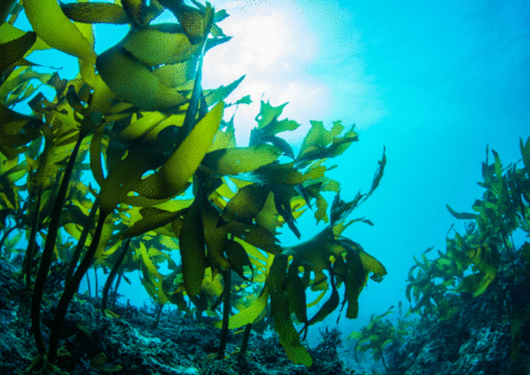
Home » Meet the New U.S. Entrepreneurs Farming Seaweed for Food and Fuel
Meet the New U.S. Entrepreneurs Farming Seaweed for Food and Fuel

October 6, 2017
It's live seaweed, and Graham - a kelp biologist and the creator of Monterey Bay Seaweeds - has been farming the stuff on a small scale in these big tanks in Moss Landing on the central coast of California for close to two years. Using more than a dozen of these big tubs and a couple of larger tanks, he produces between 50 and 100lbs of seaweed per week.
Graham, along with his wife and seven children, grow and sell their seaweed to upscale restaurants in Monterey and the San Francisco Bay Area, such as Farallon and Hog Island Oyster Company. He routinely walks into the back of these restaurants in shorts and flip-flops and hands over the live seaweed in bags of seawater to his chef customers, who use it to accompany shellfish dishes or as a sprig in a bloody mary.
Graham is part of a growing group of entrepreneurs looking to build businesses around farming seaweed, long-prized in Asian countries for its nutritional value, high-protein content and health benefits. But in contrast to many of the sprawling farms in China, these entrepreneurs are looking to create new business models, farming methods, technologies and designs that incorporate environmental sustainability and ocean biodiversity.
“This is like a backyard farm where you can sell your goods at a farmer’s market,” says Graham, gesturing to his farm a few feet from the sea and next to the Moss Landing Marine Labs, where he’s a professor in the California State University system. The only things that go into the tubs are seaweed, seawater and sunlight.
Much of the world’s seaweed is produced in large sea-based farms off the coasts of China, Indonesia, the Philippines, South Korea and Japan. This seaweed is largely dried (or sometimes blanched) and used for food, animal feed and industrial applications such as thickeners for making toothpaste. Those sushi wraps on your California roll? They most likely come from farms in Asia.
RELATED CONTENT
RELATED VIDEOS
Subscribe to our Daily Newsletter!
Timely, incisive articles delivered directly to your inbox.
Popular Stories

2024 Supply Chain Management Resource Guide: There's Only One Way Off a Burning Platform
VIEW THE LATEST ISSUECase Studies
-
Recycled Tagging Fasteners: Small Changes Make a Big Impact
-

Enhancing High-Value Electronics Shipment Security with Tive's Real-Time Tracking
-

Moving Robots Site-to-Site
-
JLL Finds Perfect Warehouse Location, Leading to $15M Grant for Startup
-
Robots Speed Fulfillment to Help Apparel Company Scale for Growth



